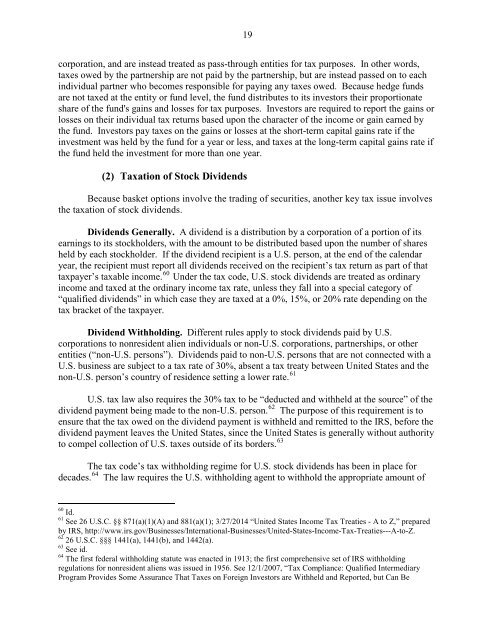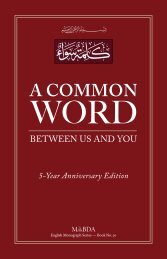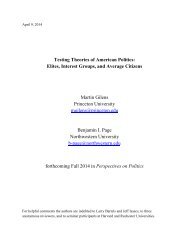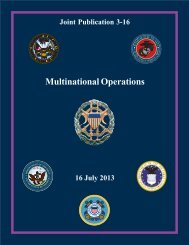ABUSE OF STRUCTURED FINANCIAL PRODUCTS- Misusing Basket Options to Avoid Taxes and Leverage Limits MAJORITY AND MINORITY STAFF REPORT
ABUSE OF STRUCTURED FINANCIAL PRODUCTS- Misusing Basket Options to Avoid Taxes and Leverage Limits MAJORITY AND MINORITY STAFF REPORT
ABUSE OF STRUCTURED FINANCIAL PRODUCTS- Misusing Basket Options to Avoid Taxes and Leverage Limits MAJORITY AND MINORITY STAFF REPORT
You also want an ePaper? Increase the reach of your titles
YUMPU automatically turns print PDFs into web optimized ePapers that Google loves.
19<br />
corporation, <strong>and</strong> are instead treated as pass-through entities for tax purposes. In other words,<br />
taxes owed by the partnership are not paid by the partnership, but are instead passed on <strong>to</strong> each<br />
individual partner who becomes responsible for paying any taxes owed. Because hedge funds<br />
are not taxed at the entity or fund level, the fund distributes <strong>to</strong> its inves<strong>to</strong>rs their proportionate<br />
share of the fund's gains <strong>and</strong> losses for tax purposes. Inves<strong>to</strong>rs are required <strong>to</strong> report the gains or<br />
losses on their individual tax returns based upon the character of the income or gain earned by<br />
the fund. Inves<strong>to</strong>rs pay taxes on the gains or losses at the short-term capital gains rate if the<br />
investment was held by the fund for a year or less, <strong>and</strong> taxes at the long-term capital gains rate if<br />
the fund held the investment for more than one year.<br />
(2) Taxation of S<strong>to</strong>ck Dividends<br />
Because basket options involve the trading of securities, another key tax issue involves<br />
the taxation of s<strong>to</strong>ck dividends.<br />
Dividends Generally. A dividend is a distribution by a corporation of a portion of its<br />
earnings <strong>to</strong> its s<strong>to</strong>ckholders, with the amount <strong>to</strong> be distributed based upon the number of shares<br />
held by each s<strong>to</strong>ckholder. If the dividend recipient is a U.S. person, at the end of the calendar<br />
year, the recipient must report all dividends received on the recipient’s tax return as part of that<br />
taxpayer’s taxable income. 60 Under the tax code, U.S. s<strong>to</strong>ck dividends are treated as ordinary<br />
income <strong>and</strong> taxed at the ordinary income tax rate, unless they fall in<strong>to</strong> a special category of<br />
“qualified dividends” in which case they are taxed at a 0%, 15%, or 20% rate depending on the<br />
tax bracket of the taxpayer.<br />
Dividend Withholding. Different rules apply <strong>to</strong> s<strong>to</strong>ck dividends paid by U.S.<br />
corporations <strong>to</strong> nonresident alien individuals or non-U.S. corporations, partnerships, or other<br />
entities (“non-U.S. persons”). Dividends paid <strong>to</strong> non-U.S. persons that are not connected with a<br />
U.S. business are subject <strong>to</strong> a tax rate of 30%, absent a tax treaty between United States <strong>and</strong> the<br />
non-U.S. person’s country of residence setting a lower rate. 61<br />
U.S. tax law also requires the 30% tax <strong>to</strong> be “deducted <strong>and</strong> withheld at the source” of the<br />
dividend payment being made <strong>to</strong> the non-U.S. person. 62 The purpose of this requirement is <strong>to</strong><br />
ensure that the tax owed on the dividend payment is withheld <strong>and</strong> remitted <strong>to</strong> the IRS, before the<br />
dividend payment leaves the United States, since the United States is generally without authority<br />
<strong>to</strong> compel collection of U.S. taxes outside of its borders. 63<br />
The tax code’s tax withholding regime for U.S. s<strong>to</strong>ck dividends has been in place for<br />
decades. 64 The law requires the U.S. withholding agent <strong>to</strong> withhold the appropriate amount of<br />
60 Id.<br />
61 See 26 U.S.C. §§ 871(a)(1)(A) <strong>and</strong> 881(a)(1); 3/27/2014 “United States Income Tax Treaties - A <strong>to</strong> Z,” prepared<br />
by IRS, http://www.irs.gov/Businesses/International-Businesses/United-States-Income-Tax-Treaties---A-<strong>to</strong>-Z.<br />
62 26 U.S.C. §§§ 1441(a), 1441(b), <strong>and</strong> 1442(a).<br />
63 See id.<br />
64 The first federal withholding statute was enacted in 1913; the first comprehensive set of IRS withholding<br />
regulations for nonresident aliens was issued in 1956. See 12/1/2007, “Tax Compliance: Qualified Intermediary<br />
Program Provides Some Assurance That <strong>Taxes</strong> on Foreign Inves<strong>to</strong>rs are Withheld <strong>and</strong> Reported, but Can Be







